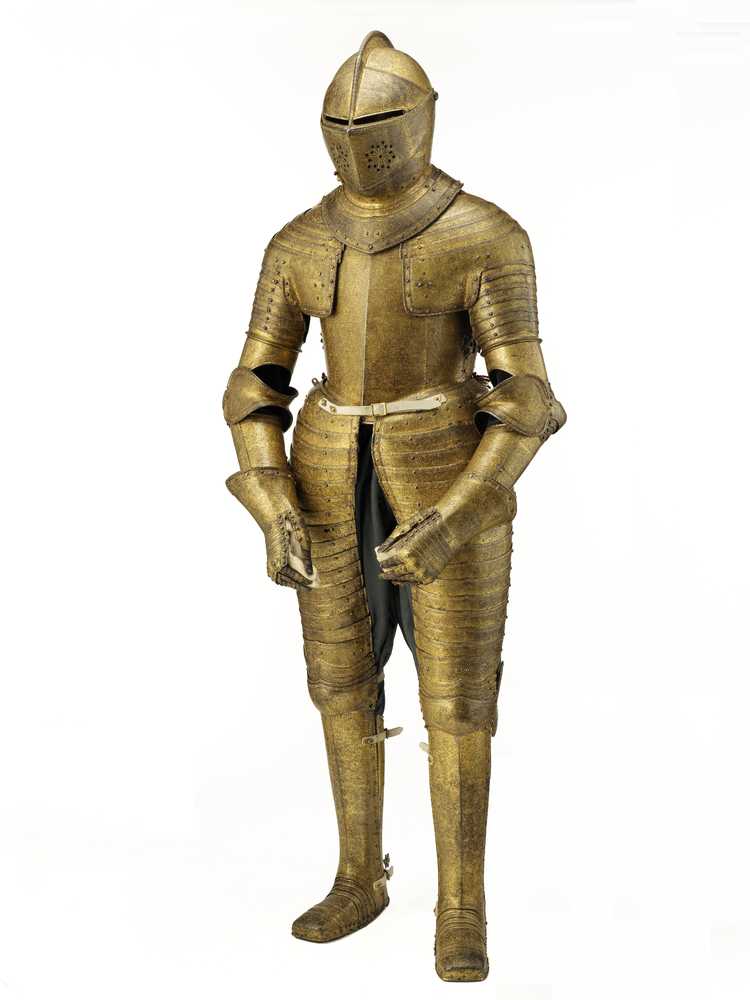During the seventeenth century the Dutch Republic produced vast quantities of arms, armour and munitions which it exported throughout Europe. Some of this trade originated in, or flowed through the city of ‘s-Hertogenbosch. With a relatively small arms industry, large quantities were sent to England, including hundreds of cuirassier armours.
The beautiful and the practical
Dating to ca. 1612 the most outstanding cuirassier armour in the Royal Armouries collection, II.91, was made in the Netherlands for Henry Prince of Wales (1594-1612) probably due to the prince’s admiration for Maurice of Nassau Prince of Orange (1567-1625), who owned a similar armour. Lavishly etched and gilded, this armour was designed to glorify the wearer; making him appear almost divine.
Less eye-catching, but more representative of the type of armour worn by cuirassiers on the battlefield, Royal Armouries II.140 is nonetheless striking. Comprising a close-burgonet, a pair of pauldrons and vambraces for the arms, a pair of gauntlets for the hands, short-waisted bullet-proof breast and backplates, a culet to protect the lower back and a pair of knee-length tassets; this type of armour was designed to provide comprehensive protection against edged weapons and particularly firearms. Armours such as these can also be found in collections in Brabant, such as in Breda’s Museum.
Wapenrusting II.140 van de Royal Armouries Leeds, in het Verenigd Koninkrijk. (Bron: Royal Armouries Leeds)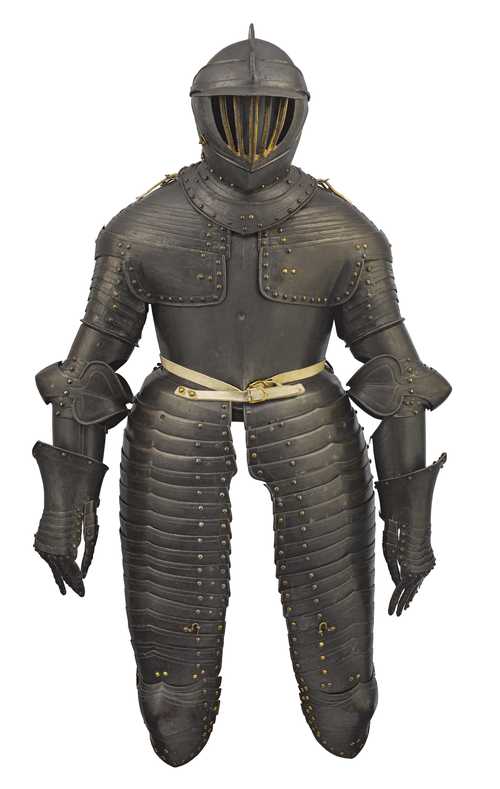
A change in mounted warfare
Firearms had been in use on European battlefields since the mid-fourteenth century. Thanks to their relative simplicity of production and ease of use, hand guns quickly established themselves as effective weapons, even in poorer regions of Europe. Although the concept of cavalry equipped with firearms had appeared in the fifteenth century, the contemporary matchlock mechanism and its use of smouldering match-cord made it unsuitable for mounted use. It was not until the development of the wheellock mechanism in the early sixteenth century, which operated on a similar principle to the modern cigarette lighter, that more wieldable firearms were developed which could easily be used from the saddle. Indeed, it enabled the creation of the first practical pistols.
This development had a significant impact on the nature of mounted warfare and gave birth to a number of new types of cavalrymen. Consequently by the end of the sixteenth century more lightly equipped cavalry armed with a range of firearms were coming to the forefront of military tactics. Less encumbered with armour these "harquebusiers" (named after the short-barrel firearm known as a "harquebus"/"arquebus") were ideally suited to a variety of tasks ranging from scouting, skirmishing and dismounting to fighting on foot. When the city of ‘s-Hertogenbosch raised its own army in 1579, it therefore also included a mixed cavalry unit, which consisted of fifty harquebusiers and fifty lancers. When the city of ‘s-Hertogenbosch raised its own army in 1579, it therefore also included a mixed cavalry unit, which consisted of fifty harquebusiers and fifty lancers.
Op deze prent van de Slag bij Turnhout in 1579 zijn op de voorgrond duidelijk kurassiers en harquebusiers te zien. Dit zijn Staatse ruiters onder de Brabandse gebroeders Bax. (Bron: Jan Luyken, 1679-1681, Rijksmuseum)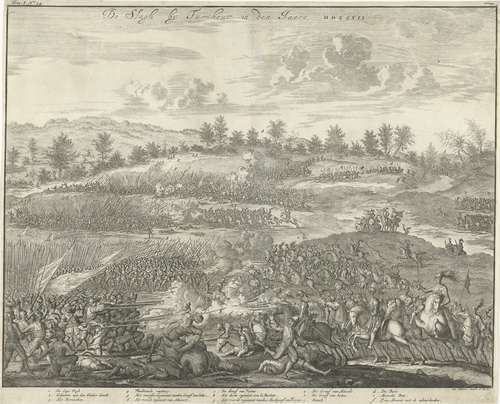
Certainly in the Netherlands the development of sophisticated fortifications and the nature of the terrain, particularly in the north, meant that warfare during the Eighty Years War was dominated by sieges rather than pitched battles. Consequently, when the Duke of Alva (1507-1582) led the Army of Flanders into Holland in 1572 he dismissed his heavily armed cavalry.
Heavy cavalry: lancers and cuirassiers
Despite these developments, the heavily armoured cavalryman had not entirely disappeared from the battlefield. Whilst the light cavalry presented numerous advantages, the heavy cavalry was still very much seen as the real battle winner. By the second half of the sixteenth century these heavy cavalrymen were largely divided into two types; the lancers who were armed with the heavy lance as their primary weapon, and the cuirassiers who were equipped with a pair of pistols.
As the descendants of the medieval knight the elite lancers enjoyed a considerable level of prestige. Whilst their use in battle could be decisive; as at Mook in 1574 and Gembloux in 1578, lancers were less versatile than cuirassiers. In 1597 Maurice of Nassau followed the general trend in Western Europe and officially abolished the lancer in the States’ Army transforming them into cuirassiers. The arming of the cuirassier differed very little from that of the lancer. Indeed, according to the English writer John Cruso, writing in 1632, the cuirassier’s equipment was virtually identical to that of a lancer.
Een radslotpistool van een kurassier uit de Tachtigjarige Oorlog. (Bron: Breda's Museum)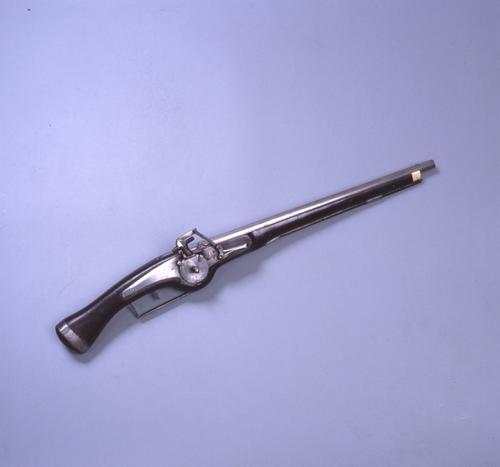
Army regulations
According to the general decree on arms and armour issued by Maurice and his cousin William Louis Count of Nassau-Dillenburg (1560-1620) in 1596 (reissued in 1599) cuirassiers were to ride strong horses, wearing breast and backplates, a visored helmet, vambraces, a gauntlet for the left-hand, a sword and a pair of pistols. The use of a single gauntlet was to allow the right hand to be free to fire the pistols.
In order to provide protection against firearms, many pieces of armour were made ‘bullet’ proof. The simplest way this was achieved was by making the plates thicker, though this inevitably also increased their weight - leading the French captain François de la Noue to compare the weight of their armour to the weight of an anvil. Indeed, the weight of Royal Armouries II.140 is a hefty 39kg.
The order went on to state that within each company of one hundred cuirassiers, 25 were to be armed with heavier armour in addition to knee-length tassets. In 1623 this was changed so that all cuirassiers within the company had to wear tassets. Rather than being permanently attached to the rest of the cuirass, the tassets and culet could be easily removed simply by unbuckling the short belt in front.
Captains, lieutenants and standard bearers were expected to be armed in the manner of their men. The quality of Royal Armouries II.140 indicates it was probably worn by an officer, whilst it’s numerous bullet-proof elements and addition of tassets certainly conforms to the Maurician decrees of 1623.
A heavy burden
Unsurprisingly such armour was more of a burden than a help. Although the Maurician orders conceded that the 25 elite cuirassiers were not required to carry their own baggage; this being entrusted to the care of a servant, many men simply discarded some of the heaviest parts of their armour. Fines were introduced in an attempt to maintain required levels of equipment, however, it is not clear how effective this measure was.
Not only was weight a factor (as highlighted above), but the cost of equipping a maintaining a company of cuirassiers was considerable. In 1623 the wages for a company of one hundred cuirassiers and 81 servants was 4,167 guilders, compared to 2800 guilders for a company of one hundred harquebusiers or 2612 guilders for a company of two hundred infantrymen. The cost and availability of suitable horses, which were required to be no less than fifteen hands high, was also another significant factor in the decline of the fully armoured cuirassier.
Op dit schilderij van Sebastiaan Vrancx plunderen soldaten een dorp. (Bron: ca. 1635, Wikimedia Commons)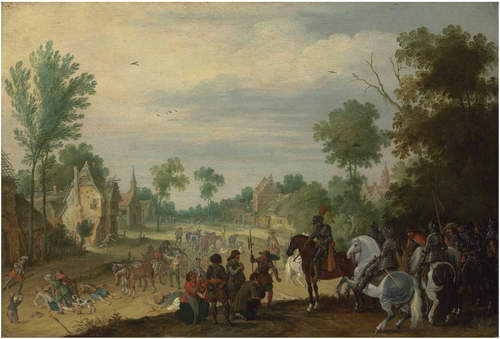
Changing roles
Over time cuirassiers were increasingly called upon to fulfil a variety of roles. No longer acting as an ‘iron wall’ on the battlefield, the nature of contemporary warfare demanded they take part in patrols and skirmishes; as depicted in the paintings by notable artists such as Sebastiaen Vrancx (1573-1647), Pieter Meulener (1602-1654) and Jan Martszen de Jonge (1609-1647). States’ cuirassiers often used the city of Bergen op Zoom as their base for such attacks. On occasion cuirassiers were also required to fight on foot when attacking fortifications. It was therefore impractical to wear full armour under such conditions.
Consequently, during the 1630s the fully armoured cuirassier became an increasingly rare sight. Despite the 1639 orders of the States’ General reaffirming that cuirassiers were be fully armoured, there is little evidence this was followed. Rather, cuirassiers either wore half armours, consisting of a helmet, back and breastplates, shoulder guards and short tassets, or more commonly simply a back and breastplate and zischägge (a light open-face helmet derived from the Ottoman çiçek) in the manner of harquebusiers. Certainly by ca.1640 the fully armoured cuirassier had disappeared from the Dutch battlefield.
Vanaf de jaren 1630 droegen cuirassiers minder wapenrusting om beweeglijker te zijn op het slagveld, met name omdat ze niet langer uitsluitend te paard vochten in het open veld. (Bron: Royal Armouries)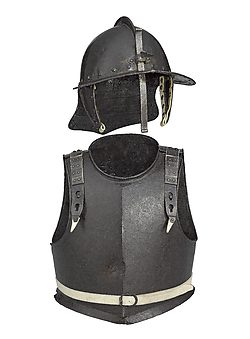
Although it is not possible to say who wore armour II.140, it is nonetheless a fascinating piece providing a window into an extraordinary period of Dutch and European history. At their height, cuirassiers were some of the most feared soldiers on the battlefield, though in the end the demands of modern warfare made them redundant.
Further Reading
Beaufort-Spontin, C. Harnische und Waffe Europas. Die militärische Ausrustung im 17. Jahrhundert, München, 1982.
Parker, G., The Military Revolution. Cambridge, 1988.
Van der Hoeven, M (eds), Exercise of Arms. Warfare in the Netherlands (1568-1648), Leiden, 1997.
Van Nimwegen, O., The Dutch Army and the Military Revolution, 1588-1688, Woodbridge, 2010.
Wijn, J.W., Het krijgswezen in der tijd van prins Maurits, Utrecht, 1934.
